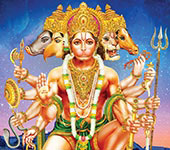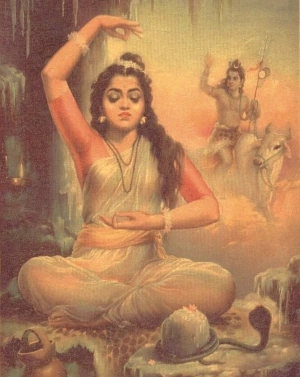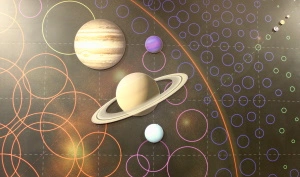Adhika Masa
In Vedic Astronomy, we look at the constellations as fixed in the sky.
The planets move through the constellations.
The sky is divided into 12 Rashis.
Each Rashi has a span of 30 degrees.
A Rashi is identified with the constellation present in it.
Movements of Sun and Moon
The Sun travels through one Rashi in about 30.43 days.
This is called a solar month.
It takes the Sun roughly 365 days to cover the entire sky.
This is called a solar year.
The Moon travels through the 12 signs in about 29.53 days.
This is a lunar month.
The duration of 12 such lunar months is about 354 days.
This is called a lunar year.
12 X solar months = solar year = about 365 days.
12 X lunar months = lunar year = about 354 days.
The difference between the two is 11 days
Need for an extra month
In the Hindu religion, both solar and lunar calendars are followed.
Some parts of the country follow the solar calendar based on the 12 solar months such as Mesha and Vrishabha.
Some other parts follow the lunar calendar based on the 12 lunar months such as Chaitra and Vaishakha.
If the difference between the two calendars @11 days per year is not taken care of, they will go completely out of sync in a few years.
For this purpose, an extra month is introduced in the lunar calendar every now and then to cover up those extra days present in the solar calendar.
This is known by the name Adhika Masa, mala Masa, or purushottama Masa.
How often is this done?
You will see that Adhika Masas are spaced apart not less than 27 months and not more than 35 months
Is this arbitrary?
No.
Adhika Masa is a phenomenon in the sky.
The point in time when Sun enters a particular Rashi is called Sankranthi.
The time at which Sun enters Mesha Rashi is Mesha Sankranthi, Vrishabha Rashi is Vrishabha Sankranthi, etc.
In the lunar calendar there are two systems:
Lunar months ending on Amavasyas; this is called Amantha calendar.
Lunar months ending on Purnimas; this is called Purnimantha calendar.
In regions like Maharashtra, and Karnataka, Amantha calendar is followed.
In North India, Purnimantha calendar is followed.
Take the Amantha calendar for an example.
Let’s say, today is Chaitra Amavasya.
Vaisakha month is supposed to start from tomorrow and end on the next Amavasya.
Vrishabha Sankranthi happens today.
But Mithuna Sankranthi does not happen before the next Amavasya.
Let’s say it happens one day after the next Amavasya.
That means the entire next month does not have a Sankranthi.
Such months (those without a Sankranthi) are called Adhika Masas.
The first one, in this case, Phalguna, will be called Nija Chaitra.
Nija means real.
The extra month without a Sankranthi will be called Adhika Chaitra.
The subsequent one will be Jyeshta, as usual.
Religious importance
Functions such as griha pravesha and samskaras are avoided during Adhika Masa.
The term Mala Masa (impure month) signifies this.
At the same time, the name Purushottama Masa signifies that the entire month should be dedicated to sadhana, upasana, vrata, upavasa, japa, parayana, and pilgrimage.
Adhika Masa is similar to grahana: inauspicious but very good for sadhana.
Adhik Maas 2022
Thre is no Adhik Maas in the year 2022
Adhik Maas 2023
Shravan Adhik Maas - 18, July to 16 August, 2023.
Quiz
Which is the branch of astrology in which questions are answered based on the planetary positions at the time of asking the question ?Recommended for you
How is Jarasandha related to Kamsa?

Jarasandha is the father-in-law of Kamsa. Two daughters of Jarasandha, Asti, and Prapti were married to Kamsa.....
Click here to know more..A minor curse by Rishis made Lord Hanuman to forget his power
 Click here to know more..
Click here to know more..
Parvati Pranati Stotram

bhuvanakelikalaarasike shive jhat'iti jhanjhanajhankri'tanoopoore. dhvanimayam bhavabeejamanashvaram jagadidam tava shabdamayam vapuh'. vividhachitrav....
Click here to know more..
English Topics
Astrology
Click on any topic to open
- 93 Is it a Good Day for You Today and Tomorrow?
- 92 What Is Kari Naal?
- 91 Revati Nakshatra Famous Personalities
- 90 Uttara Bhadrapada Nakshatra Famous Personalities
- 79 Purvabhadra Nakshatra Famous Personalities
- 78 Satabhisha Nakshatra Famous Personalities
- 77 Dhanishta Nakshatra Famous Personalities
- 76 Shravana Nakshatra Famous Personalities
- 75 Uttarashada Nakshatra Famous Personalities
- 74 Purvashada Nakshatra Famous Personalities
Please wait while the audio list loads..
30
Ganapathy
Shiva
Hanuman
Devi
Vishnu Sahasranama
Mahabharatam
Practical Wisdom
Yoga Vasishta
Vedas
Rituals
Rare Topics
Devi Mahatmyam
Glory of Venkatesha
Shani Mahatmya
Story of Sri Yantra
Rudram Explained
Atharva Sheersha
Sri Suktam
Kathopanishad
Ramayana
Mystique
Mantra Shastra
Bharat Matha
Bhagavatam
Astrology
Temples
Spiritual books
Purana Stories
Festivals
Sages and Saints
